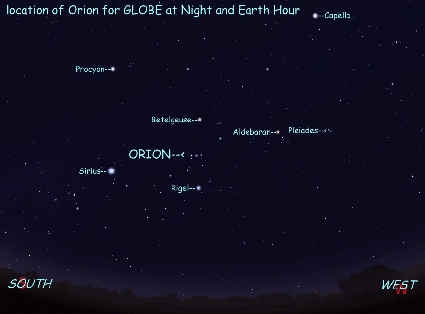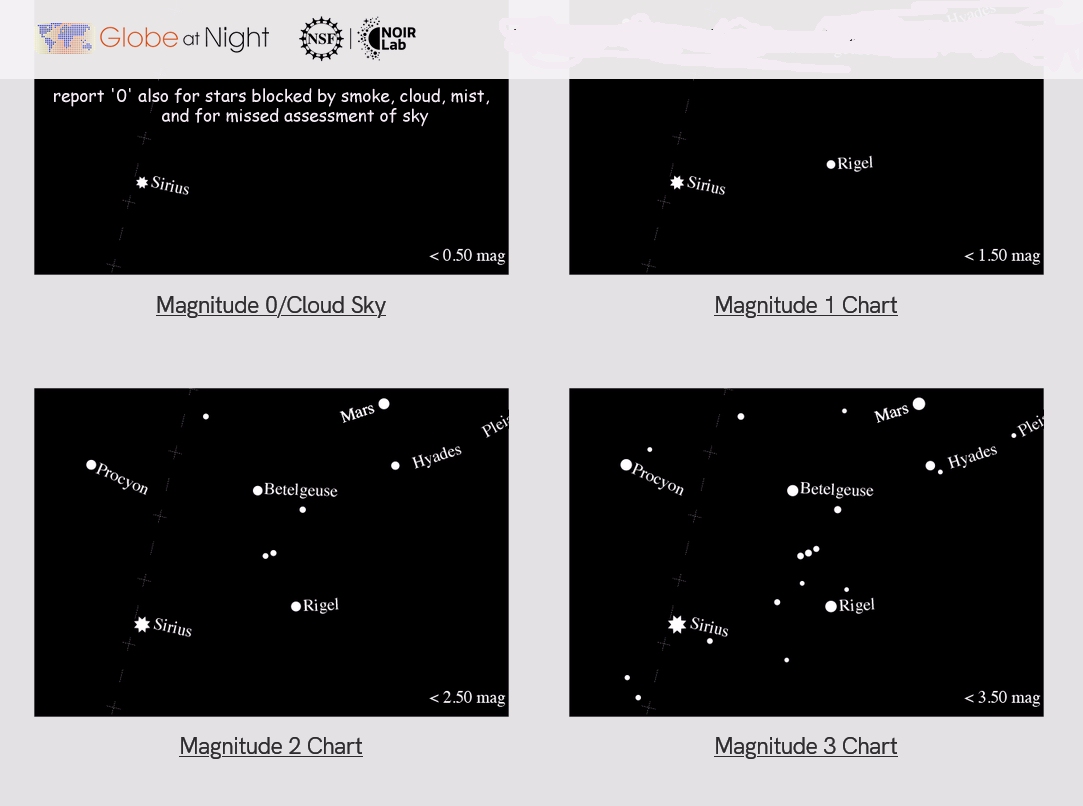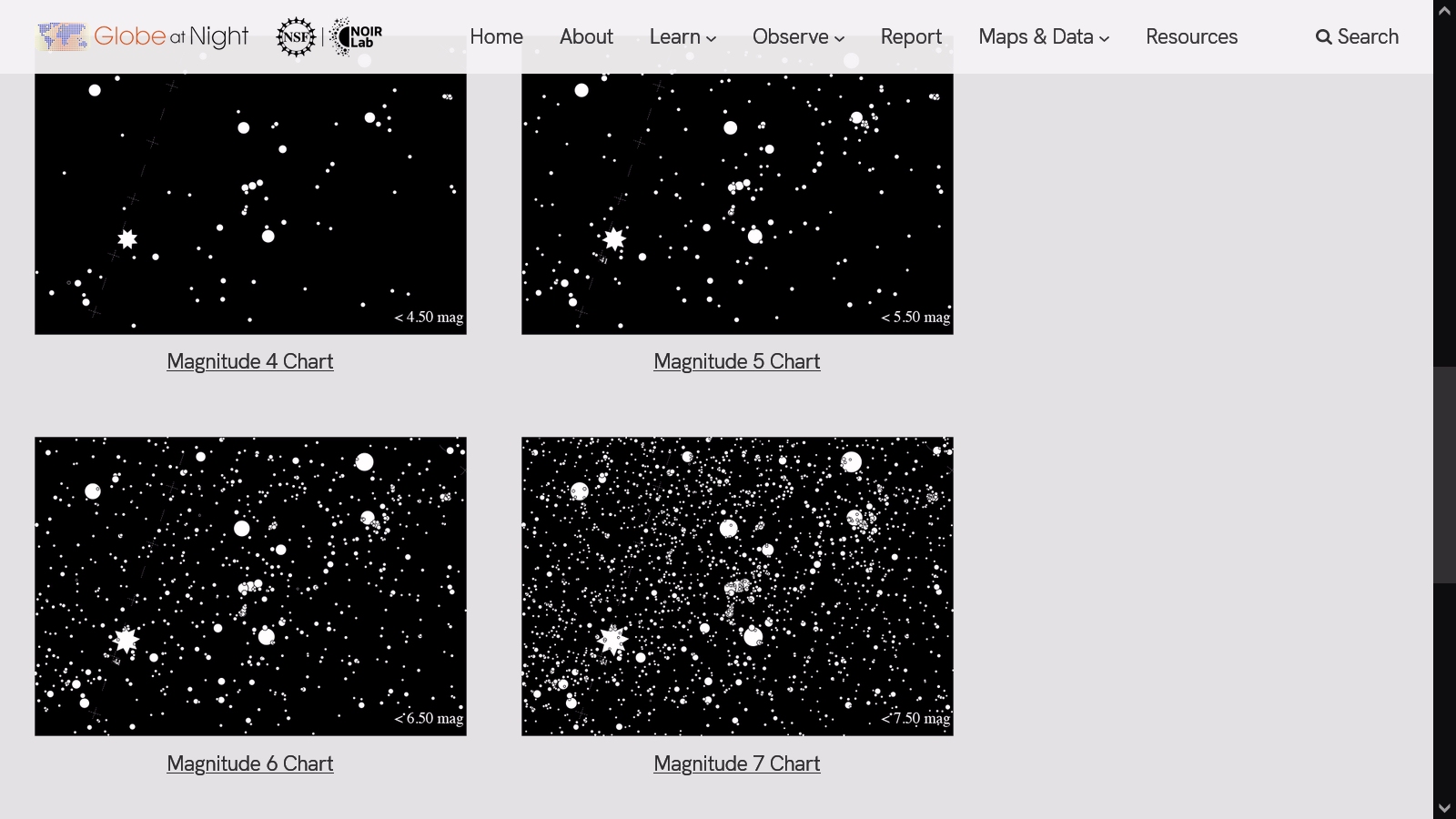| NYSkies Globe at
Night and Earth Hour
Thank you for participating in the Globe at Night (GaN)
citizen science project! Observations are collected du ng
these intervals:
2025-2026
---------
Nvember 11-20
December 10-19
January10-19
February 9-18
March 10-19
also 2026
March 28 20:30-21:30 EDST for Earth Hour
NYSkies no longer does
April. Orion is low in west at dusk.
During these spans,
observers all over the world measure the amount of
luminous graffiti (light pollution) in their communities.
The expanded season for Globe at Night comes largely from
agitation by NYSkies to cover more of the evening
apparition of Orion.
NYSkies,
in addition to the GaN dates, includesncludes Earth Hour.
This is a specially important extra opportunity for
collecting valuable sky data. Earth Hour is explained
below.
NYSkies coordinates this effort for
New York City, with advice and consultation for all
participants. Please call on NYSkies for questions
regarding Globe at Night. We are at
/‘nyskies@nyskies.org’.
View from any location you normally
frequent as long as the Orion constellation in evening is
in open sky from it. Try to avoid or block nearby lights
from shining into your face. The location may be at or
near your home, school, workplace, or a waypoint you pass
in your goings about.
Do NOT purposely go to s special
‘dark sky’ location which you do not routinely
use for starviewing. The intent of GaN is to collect sky
data from as many diverse types of location as practical.
For this location, note the
geographic position, like a street address or street
corner, and its general description. The position should
be within 30 meters, if possible.
You may view Orion from shelter, like
thru an open room or car window . This may be necesssary
for in extreme cold or wind. Such shelter can help block
local lights from your face.
Wait a couple minutes for your eyes to
adapt to the dark. You may merely close you eyes and rest
during this time. Taking measurements immediately after
leaving a brightly lighted surrounds, like indoors, will
result in low value data. Do wait for dark adaption.
Find Orion in the evening sky. The
skyscape here shows what to look for in March. Use a
planetarium program to check other months and hours. The
number and density of stars will depend on the clarity of
the instant evening. Orion will be a little higher for
earlier dates and hours; lower, later. When Orion is
below 20 degree altitude, it may be too low for good
viewing.

Compare your own view of Orion with the charts below.
Note which chart best represents the aspect of Orion for
the number and density of stars you see on the specific
night.
Record the chart number that best
matches your view of Orion. This will help determine the
dimmest stars that you saw at your location under the
prevailing sky and luminous graffiti conditions of each
night.
Globe at Night is NOT a vision test!
It is NOT a contest for the 'best' report! There are
variations of eye sensitivity and acuity and of
skyywatching experience among observers.
Give the chart number that best
characterizes the sky for your own observation. If you
work in a group, you may report a group agreement or
supply individual results.
Include for each observation the date
and hour and comment about the sky conditions, cloud
& haze, hotspots from luminous graffiti, and general
weather. Mind the shift from EST to EDST in the
March-April GaN periods.
Report your observations to NYSkies as
soon as practical by email at
h‘nyskies@nyskies.org’. You may copy/paste the
form, with your filled-in fields, into the email or put
all of its requested information in new text.
Try to view Orion on as many nights as
practical during the Globe at Night periods. Sky
conditions can shift from night to night and bad weather
may intervene. One viewing per night is sufficient,
unless for some reason there is a drastic change of sky
conditions. This may occur during Earth Hour.
The observations from around the world
will be tabulated and plotted by the GaN office on its
global Sky Brightness Map by this coming summer. NYSkies
will post the New York reports in its website at
‘www.nyskies.org’.
When reading the charts at
night, use the least amount of additional light
practical, or use a red lamp, to preserve your night
vision.
An other skywatching project relates
to Earth Hour (EH). This is a campaign against carbon
emissions into the air. It runs during the 20:30-21:30
hour in each location's timezone. This worldwide effort
suspends the use of carbon-based fuel, commonly the
source for electric power. One way to reduce carbon
emission is to shut off nonessential electric devices.
These include outdoor lighting that can cause luminous
graffiti. Further reduction in carbon output is to turn
off direct combustion of carbon-based fuel, like stoves,
heaters, and lamps.
Because EH may reduce luminous
graffiti by the abatement of excess outdoor
lighting, NYSkies is collecting luminous graffiti
data for EH using the GaN method. Please take sky
measurements, using the instructions and charts here, at
about 20:00, 21:00, and 22:00 EDST. For some observers
Orion may be too low at 22:00 for good viewing. Report
the results to NYSkies like for the Globe at Night
measurements.
Charts of Orion


---8ß --cut here----8ß --cut here----8ß --cut here----8ß --cut here----8ß --cut here----8ß --
Fill
out and then by copy-&-paste send it to NYSkies at
‘nyskies@nyskies.org’. Or write a new email
with all of the requested information in it.
Observer/contact
name ____________________________________________________
Observer/contact
email
________________________________@_____________________
Observer/contact
day phone number
(
________) ______________________________
Observer/contact
evening phone number (
________) ______________________________
Group name, or
‘individual’ _______________________________
Date, hour
(within 10 minutes), tunezone
_________________________________-
(The dates for
GaN and EH are near the top of these instructions)
Viewing site
(address/street corner, structre, landmarll /topographic
location___________________________________
City/town
& state/province ___________________________________.
Elevation
avoce grade ______ meter/floor
Site
description (open field, beach, roof top, &c)
____________________________________
Chart number
__________ __.
ky conditionsr
(haze clear & dark, cloud cover, aurora, smok.e,
s&c)_________
______________________________________________________
wearther
(rain/snow, humid, cold/frigid, wind, swelter,
&c)___________________________________________
code number of
chart best fitting sky view _______________________
for group, give count of each reported code
|


